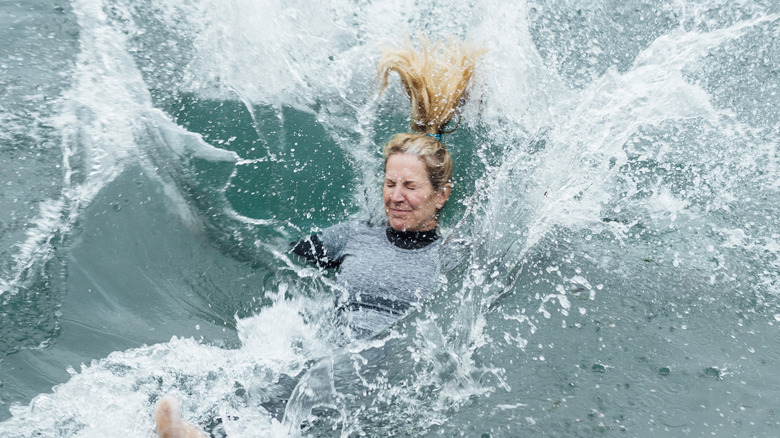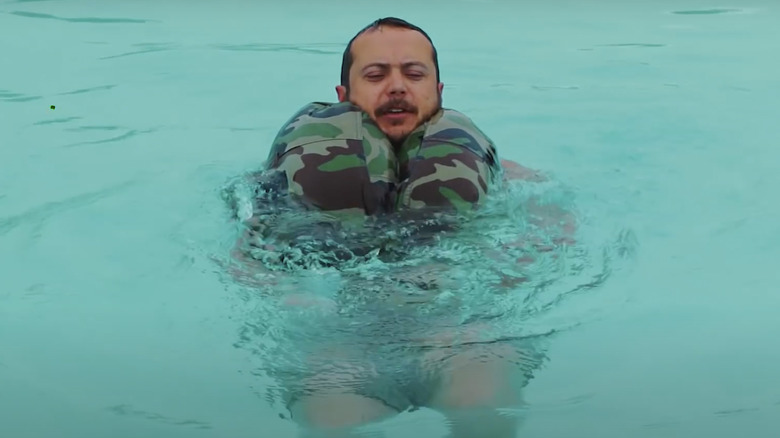Keep Yourself From Drowning After Falling Into The Water Fully Clothed With This Genius Trick
It's never fun to unexpectedly fall into the water, and even less so if you are unprepared and fully clothed. However, it's a serious threat, with drowning being one of the most common ways people die while fishing and one of the most common ways people die in the wilderness. Falling into the water fully clothed can be a terrifying thing and it leads some people (even experienced swimmers) to panic and drown.
There's been a rumor for a while that falling in the water with clothes on is basically a death sentence. The truth is, while wearing a lot of clothes can make it difficult to get out of the water, for the most part, it doesn't make the process of swimming any more difficult. It will reduce swim endurance and speed, but unless you have to travel long distances, there's not much danger.
This means that, thankfully, falling into the water with clothes on doesn't immediately mean you're doomed. Depending on what you're wearing, you can actually turn your heavy, waterlogged clothes in your favor by transforming them into a flotation device. Fabrics like denim, waterproof fabrics, and other thick materials do a great job of trapping air and helping you to float.
Using your clothes to float
Coachmikenitro on Instagram demonstrates the technique, if you aren't quite sure how to fill your pants with air. Though he is in a pool instead of a natural body of water, the idea is the same. When possible, you want to take off your pants, especially if they're jeans or other heavy material. Though it might be scary, this process will involve going under the water, so take a big, deep breath. Depending on the fit of your jeans, it may take a couple of tries to get them all the way off.
Once you have the pants fully off, you'll want to tie the ends of the legs together. Make sure the knot is nice and tight. Then, in the open end, you'll want to put some air in the pants. You can do this by sweeping the pants around, or by splashing water into the opening. If some water gets into the float, it's fine, so long as you also start building air in there.
At the end of the video, Coachmikenitro simply wraps the pants around him. While you may want to tie the other end shut to free both your hands, it's often better to not do that, as then you can easily refill the jeans with air as needed. It's also important to note that you'll want to make sure the jeans stay fully wet to best trap the air.
Stay calm and adjust to your situation
There is some mixed information when it comes to whether or not you should take off your clothes if you fall into the water. Most sources, like Minnesota's Department of Natural Resources, say that the extra insulation will keep you just a little warmer in cold water and won't drag you down enough to actually cause a problem. The only possible exception is shoes, as some types increase drag or are heavy enough to tire out your legs.
Most clothes will provide some layer of insulation and a bit of a boost to your floating if you leave them on. Clothes trap air, which helps you float to the top. So even if you don't have clothes you can turn into a flotation device, you can get a bit of a boost if you leave your clothes on.
If your clothes help keep you warm and buoyant, keep them on. However, if you have to swim a long distance, or you're struggling to stay afloat, take off your clothes and use them as a flotation device. During situations with rapids and fast moving water, you may want to take off clothes to reduce drag if you have the chance before they sweep you away. Rapids can be fast, as Bear Grylls reveals in his harrowing footage where he nearly lost his life, and you want as little resistance as possible.

